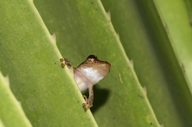|
Description
The species G. bicalcaratus has originally been described from Nosy Boraha, and this name afterwards been applied widely to populations of brown and inconspicuously coloured Pandanus frogs. Genetic data indicate that most of these populations are strongly differentiated from Nosy Boraha specimens. Furthermore, two clearly distinct species occur syntopically at Nosy Boraha.
This species can be distinguished from other species of the Pandanusicola subgenus by differences in tympanum diameter and coloration. M. liber has larger hands and feet (Glaw et al. 1994).
Distribution and Habitat
Country distribution from AmphibiaWeb's database: Madagascar
Nosy Boraha, Andranofotsy. It occurs from sea level to 1,200m asl (Nussbaum and Raxworthy 2008).
Life History, Abundance, Activity, and Special Behaviors
It is an arboreal species of rainforest, including degraded forest. It has also been found in eucalyptus plantations, but not in open areas. It lives and breeds in Pandanussp. leaf axils by larval development. Active during the day (Nussbaum and Raxworthy 2008).
Calls: Recorded from Fenoarivo and possibly to be assigned to typical G. bicalcaratus. Fast series of four click notes. Calling males were heard all year around, mainly in the evening, but sometimes, after heavy rain, during the day.
The tadpoles are adapted to phytotelmioc habitats by their flattened shape. As in M. Pulcher, the larvae of this species were observed leaving the water vertically along a smooth plastic surface. They heavily wind with the tail and adhere to the underground after movement. They probably have the ability to move between the different water bodies in the phytotelms (Glaw et al. 1994).
Trends and Threats
It occurs in many protected areas (Nussbaum and Raxworthy 2008).
Possible reasons for amphibian decline General habitat alteration and loss
Habitat modification from deforestation, or logging related activities
Intensified agriculture or grazing
Habitat fragmentation
Comments
Taken with permission from Glaw and Vences (2007).
References
Glaw, F. and Vences, M. (1994). Amphibians and Reptiles of Madagascar. M. Vences and F. Glaw Verlags GbR., Köln.
Glaw, F., and Vences, M. (2007). Field Guide to the Amphibians and Reptiles of Madagascar. Third Edition. Vences and Glaw Verlag, Köln.
Nussbaum, R. and Raxworthy, C. (2008). Guibemantis bicalcaratus. In: IUCN 2008. 2008 IUCN Red List of Threatened Species. www.iucnredlist.org. Downloaded on 01 April 2009.
Originally submitted by: Miguel Vences and Frank Glaw (first posted 2000-09-25)
Edited by: Henry Zhu (2009-05-06)Species Account Citation: AmphibiaWeb 2009 Guibemantis bicalcaratus <https://amphibiaweb.org/species/4584> University of California, Berkeley, CA, USA. Accessed May 22, 2025.
Feedback or comments about this page.
Citation: AmphibiaWeb. 2025. <https://amphibiaweb.org> University of California, Berkeley, CA, USA. Accessed 22 May 2025.
AmphibiaWeb's policy on data use.
| 